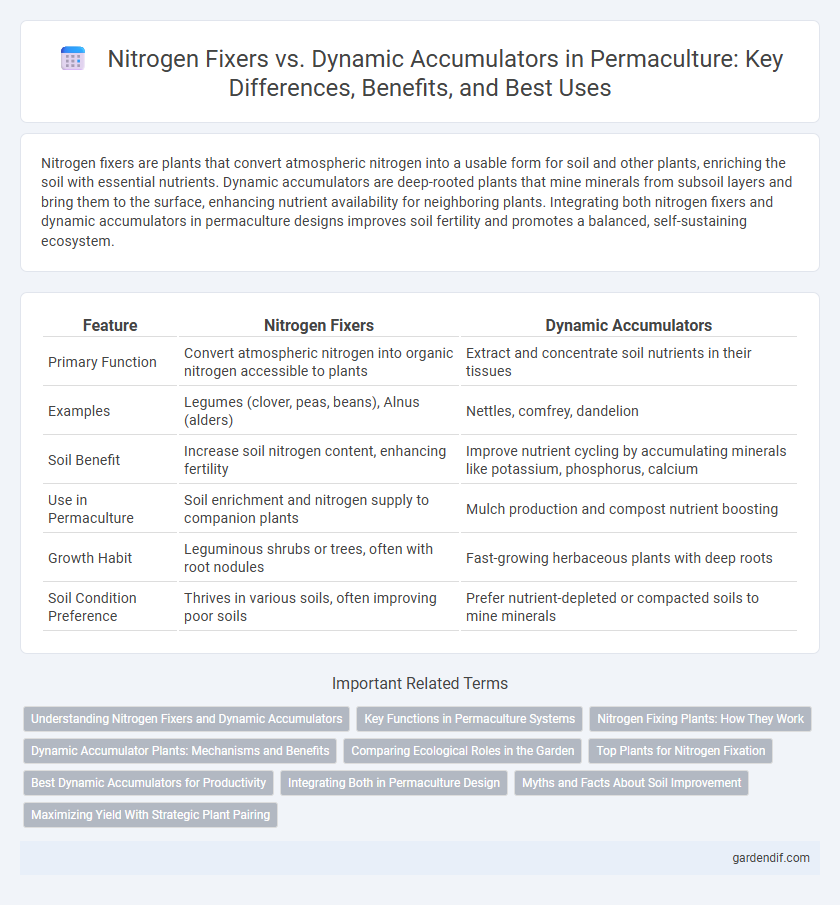
Nitrogen Fixers vs Dynamic Accumulators Illustration
Nitrogen fixers are plants that convert atmospheric nitrogen into a usable form for soil and other plants, enriching the soil with essential nutrients. Dynamic accumulators are deep-rooted plants that mine minerals from subsoil layers and bring them to the surface, enhancing nutrient availability for neighboring plants. Integrating both nitrogen fixers and dynamic accumulators in permaculture designs improves soil fertility and promotes a balanced, self-sustaining ecosystem.
Table of Comparison
| Feature | Nitrogen Fixers | Dynamic Accumulators |
|---|---|---|
| Primary Function | Convert atmospheric nitrogen into organic nitrogen accessible to plants | Extract and concentrate soil nutrients in their tissues |
| Examples | Legumes (clover, peas, beans), Alnus (alders) | Nettles, comfrey, dandelion |
| Soil Benefit | Increase soil nitrogen content, enhancing fertility | Improve nutrient cycling by accumulating minerals like potassium, phosphorus, calcium |
| Use in Permaculture | Soil enrichment and nitrogen supply to companion plants | Mulch production and compost nutrient boosting |
| Growth Habit | Leguminous shrubs or trees, often with root nodules | Fast-growing herbaceous plants with deep roots |
| Soil Condition Preference | Thrives in various soils, often improving poor soils | Prefer nutrient-depleted or compacted soils to mine minerals |
Understanding Nitrogen Fixers and Dynamic Accumulators
Nitrogen fixers are plants that convert atmospheric nitrogen into forms usable by other plants, significantly enriching soil fertility through symbiotic relationships with bacteria like Rhizobium. Dynamic accumulators, on the other hand, are deep-rooted plants that mine essential nutrients such as potassium, phosphorus, and calcium from subsoil layers, bringing them to the surface where they become accessible to shallow-rooted species. Understanding these roles helps permaculturists design sustainable systems that optimize nutrient cycling and improve overall ecosystem health.
Key Functions in Permaculture Systems
Nitrogen fixers are plants that convert atmospheric nitrogen into usable forms, enriching soil fertility and supporting plant growth in permaculture systems. Dynamic accumulators absorb nutrients from deep soil layers and concentrate them in their biomass, which, when decomposed, enhances nutrient cycling and soil health. Integrating both nitrogen fixers and dynamic accumulators maximizes soil nutrient availability and promotes sustainable ecosystem productivity.
Nitrogen Fixing Plants: How They Work
Nitrogen fixing plants, such as legumes, form symbiotic relationships with Rhizobium bacteria in their root nodules, converting atmospheric nitrogen into ammonia usable by plants. This biological nitrogen fixation enriches soil fertility naturally, reducing the need for synthetic fertilizers. Unlike dynamic accumulators that mine nutrients from deep soil layers, nitrogen fixers directly increase nitrogen availability, promoting healthy plant growth and ecosystem balance in permaculture systems.
Dynamic Accumulator Plants: Mechanisms and Benefits
Dynamic accumulator plants enhance soil fertility by mining deep nutrients such as potassium, phosphorus, calcium, and trace minerals through extensive root systems and concentrating them in their leaves and biomass. When these plants, including comfrey, dandelion, and nettle, are chopped and dropped or used as mulch, they release essential nutrients back into the topsoil, improving nutrient availability for surrounding crops. Their role in nutrient cycling supports sustainable permaculture systems by reducing the need for synthetic fertilizers and fostering healthy soil microbiomes.
Comparing Ecological Roles in the Garden
Nitrogen fixers, such as clover and alfalfa, play a critical role in enriching soil by converting atmospheric nitrogen into a form usable by plants, directly boosting soil fertility. Dynamic accumulators like comfrey and yarrow specialize in mining deep soil nutrients and making them accessible to shallow-rooted plants through their leaf litter. Together, these plant categories enhance garden ecosystems by improving soil nutrient cycling and promoting sustainable plant growth without synthetic fertilizers.
Top Plants for Nitrogen Fixation
Top plants for nitrogen fixation include legumes such as clover, vetch, and lupines, which form symbiotic relationships with Rhizobium bacteria to convert atmospheric nitrogen into bioavailable forms. These nitrogen fixers play a critical role in permaculture by naturally enhancing soil fertility and reducing the need for synthetic fertilizers. Unlike dynamic accumulators, nitrogen-fixing plants directly contribute to nitrogen cycling by enriching the soil with essential nutrients for subsequent crops.
Best Dynamic Accumulators for Productivity
Dynamic accumulators like comfrey, yarrow, and dandelion excel at mining essential nutrients from deep soil layers, boosting soil fertility and plant productivity. Comfrey, rich in potassium and calcium, rapidly accumulates biomass that can be used as a nutrient-rich mulch, enhancing crop yields. Yarrow improves soil structure and attracts beneficial insects, while dandelion mobilizes phosphorus and iron, making them key species for sustainable permaculture systems focused on maximum productivity.
Integrating Both in Permaculture Design
Integrating nitrogen fixers and dynamic accumulators in permaculture design maximizes soil fertility by enhancing nutrient cycling and availability. Nitrogen fixers, such as legumes, convert atmospheric nitrogen into bioavailable forms, while dynamic accumulators, like comfrey and yarrow, mine deep soil minerals and bring them to the surface. Strategically planting these species together creates a synergistic effect that improves soil health, supports diverse plant growth, and reduces the need for synthetic fertilizers.
Myths and Facts About Soil Improvement
Nitrogen fixers, such as legumes, convert atmospheric nitrogen into a form usable by plants, enhancing soil fertility by naturally increasing nitrogen levels, while dynamic accumulators are plants believed to concentrate specific nutrients from deep soil layers but scientific evidence supporting their effectiveness remains limited. A common myth is that dynamic accumulators significantly improve soil health, but research shows their role is mainly in adding organic matter rather than directly altering nutrient availability. Understanding the distinct functions of nitrogen fixers and verifying claims about dynamic accumulators is crucial for effective permaculture soil management and sustainable garden practices.
Maximizing Yield With Strategic Plant Pairing
Nitrogen fixers like legumes enrich soil by converting atmospheric nitrogen into forms usable by plants, enhancing overall soil fertility and boosting crop yields. Dynamic accumulators such as comfrey and yarrow mine deep soil nutrients and concentrate minerals in their leaves, which decompose to improve nutrient availability. Strategic pairing of nitrogen fixers with dynamic accumulators maximizes yield by combining nitrogen enrichment with targeted mineral cycling, creating a balanced and fertile permaculture ecosystem.
Nitrogen Fixers vs Dynamic Accumulators Infographic

 gardendif.com
gardendif.com